- NJASA
- Community Corner June 2018


-
The New Generation of Nicotine Addiction
The emergence of the electronic cigarette industry has the potential to create a new generation of nicotine addiction, beginning with current middle and high school students. E-cigarette use poses a significant yet avoidable health risk to young people. The use of these products increases the possibility of addiction and long-term harm to brain development and respiratory health. Statistics show e-cigarette use is associated with combined use of other tobacco products that can do even more damage to the body. The 2017 National Youth Tobacco Survey was released on June 7, 2018 and shows a slight uptick of high school students using e-cigarettes at 11.7%.
The 2017 National Youth Tobacco Survey shows that youth cigarette smoking is at record lows, but far too many kids still use some form of tobacco. The continuing popularity of electronic cigarettes and cigars – products that are widely available in sweet, kid-friendly flavors – is a particular cause for concern. For the fourth year in a row, e-cigarettes are the most commonly used tobacco product among both middle and high school students, while slightly more high school students now smoke cigars than cigarettes. (CDC) Since 2014, e-cigarettes have been the most commonly used tobacco product among both middle and high school students. (CDC)
US 2016 Youth Tobacco Survey Data
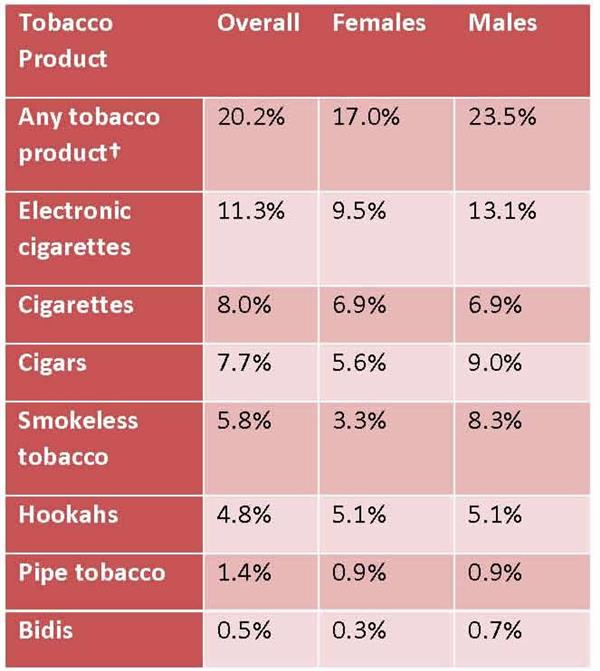
US 2017 Youth Tobacco Survey Data https://www.cdc.gov/mmwr/volumes/67/wr/mm6722a3.htm#F1_down
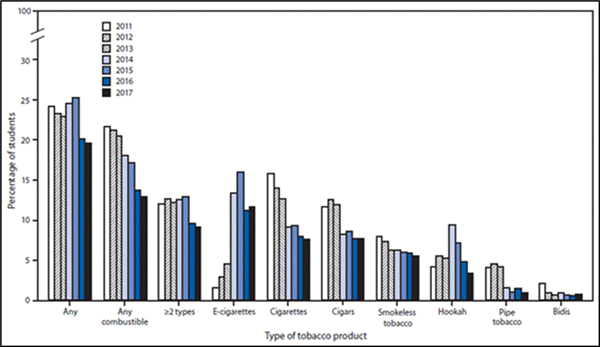
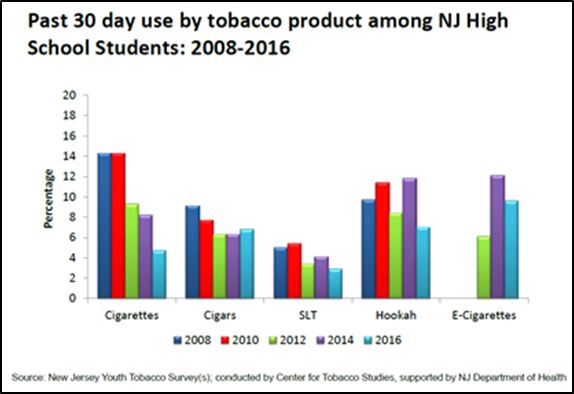
31.8% of high school students that every used tobacco states that e-cigarettes was the first product they ever tried.
An electronic cigarette (e-cigarette) is a battery-powered heating device that does not burn or use tobacco leaves but instead delivers nicotine, when nicotine is present, in the form of an aerosol that the user then inhales. Many of these devices are manufactured overseas and are not currently regulated under the FDA 2016 regulations; which is now delayed. The components of an e-cigarette include the battery; which powers the atomizer. The atomizer is the heating element that heats the e-liquid and is often coil-shaped. The e-liquid is added into the cartridge; which has a variety of sizes. When the e-liquid is heated, it creates the aerosol that is inhaled. E-cigarettes can be disposable, for one-time use or refillable and rechargeable for multi-use. The refillable and rechargeable e-cigarettes come in medium and large tank (cartridge) styles and can sometimes be called “mods”. There are also e-cigars and e-pipes. Fifty-four percent of the e-cigarette market is currently controlled by an e-cigarette called JUUL.
JUUL (“jewel”) is produced by JUUL Labs, Inc. in California and, until recently, was only available online. Now, convenient stores like Wawa sells JUUL at a discounted price. JUUL is a small, black e-cigarette that looks like a USB flash drive and is rechargeable. They can be easily hidden in a pocket or a fist. JUUL uses prefilled “pods” of e-liquids that contain high levels of nicotine, flavorings and other substances. The terminology of using the device is called “juuling.” JUUL comes in youth-friendly flavors such as mango, mint, and fruit medley. The nicotine in one JUUL pod is equivalent to the amount of nicotine in an entire pack of cigarettes, putting kids at a greater risk of addiction. The aerosol produced by JUUL is not as noticeable as other e-cigarettes, making it difficult to detect. Youth are using JUUL in schools and sharing them with their peers. USA Today reports that 63% of those ages 15 – 24 who use JUUL don’t know that the product always contains nicotine. JUUL’s website https://www.juul.com/ provides the following warnings:
Warning:
This product contains nicotine. Nicotine is an addictive chemical.
California Proposition 65 Warning:
This product contains chemicals known to the state of California to cause cancer and birth defects or other reproductive harm.
The 2017 National Youth Tobacco Survey may understate actual youth use of e-cigarettes as it was conducted in the spring of 2017 and does not fully capture the recent, widely-reported surge in popularity of Juul e-cigarettes among teens. Juul was not specifically mentioned in the survey, and many teens refer to Juul use as “juuling,” indicating they may not consider it to be using an e-cigarette. (CDC)
There is a perception that e-cigarettes do not contain nicotine and that the e-liquid is just harmless water vapor. However; the aerosol from e-cigarettes is not harmless. It can contain harmful chemicals, including nicotine, propylene glycol or glycerin, and flavoring such as diacetyl, a chemical linked to a serious lung disease. Some e-cigarette manufacturers claim these ingredients are safe because they meet the FDA definition of “Generally Recognized as Safe” for food additives, however, have not been approved for inhalation. The ingredients and concentration of the nicotine in e-liquids are inconsistent and difficult to find on packaging. Currently, there are close to 8,000 flavors of e-liquid available, with names like unicorn puke, created to attract youth. According to the Surgeon General’s report, 85% of e-cigarette users ages 12-17 stated that appealing flavors was a reason for initiation for e-cigarette use. The effects of many of these inhaled ingredients are largely unknown.
Other chemicals found in e-cigarettes can include: ultrafine particles that can be inhaled deep into the lungs; volatile organic compounds such as benzene, which is found in car exhaust; and heavy metals, such as nickel, tin, and lead. Scientists are still working to understand more fully the health effects and harmful doses of e-cigarette contents when heated and turned into an aerosol, both for active users who inhale from a device and for those who are exposed to the aerosol secondhand.
The National Academy of Sciences, Engineering, and Medicine’s Public Health Consequences of E-cigarettes brief had the following conclusions: conclusive evidence that exposure to nicotine from e-cigarettes is highly variable and depends on product characteristics (including device and e-liquid characteristics) and how the device is operated. Conclusive evidence that in addition to nicotine, most e-cigarette products contain and emit numerous potentially toxic substances. Substantial evidence that e-cigarette use increases risk of ever using combustible tobacco cigarettes among youth and young adults. Youth who experiment with tobacco products experiment with multiple tobacco products.
The e-cigarette industry is using marketing tactics specifically to attract youth. According to the CDC, more that 18 million US middle and high school youth were exposed to e-cigarette ads in 2014. The study also shows that more than 1 in 2 middle and high school youth were exposed to e-cigarette ads in retail stores and 2 in 5 saw e-cigarette ads online. Many of these ads glamorize e-cigarettes with celebrity and sports endorsements that target youth. “One of the biggest concerns among health officials is the potential for e-cigarettes to become a path to smoking among young people who otherwise would not have experimented” (New York Times).
In January, 2010, New Jersey included e-cigarettes in the 2006 Clean Indoor Air Act. In November of 2017, NJ raised the age of sale to 21 of all tobacco products, including electronic devices. The New Jersey Department of Health, Office of Tobacco Control, Nutrition, and Fitness’ statewide initiative Tobacco Free for a Healthy NJ (TFHNJ), provides education on e-cigarettes for professionals and parents and an interactive presentation “To Vape or not To Vape,” an interactive presentation for youth. Youth can be directed to TFHNJ’s “DontgetVapedIn” website and social media outlets to learn more about the dangers and risks of experimenting with e-cigarettes.
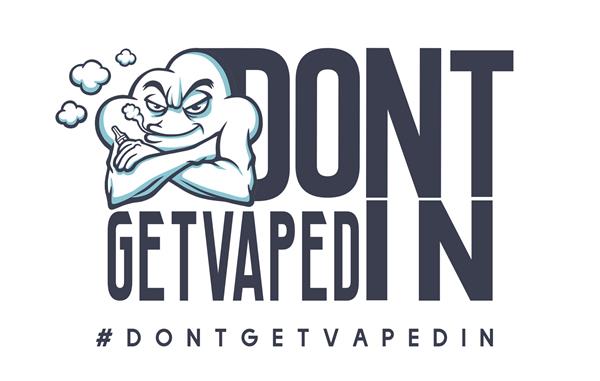
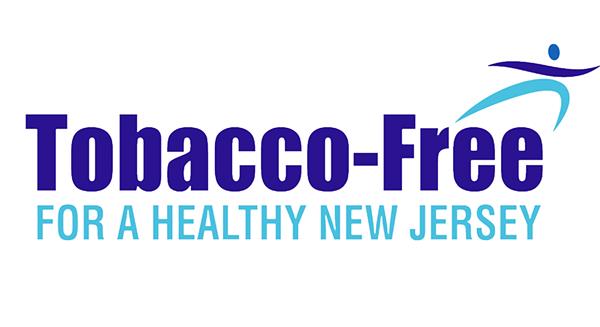
Material:
https://e-cigarettes.surgeongeneral.gov/documents/2016_sgr_full_report_non-508.pdf
https://e-cigarettes.surgeongeneral.gov/documents/SGR_ECig_ParentTipSheet_508.pdf
https://e-cigarettes.surgeongeneral.gov/documents/2016_SGR_ECig_FAQ_508.pdf
https://www.cdc.gov/tobacco/basic_information/e-cigarettes/index.htm
http://www.tobaccofreenj.com/ends/
Resources:

